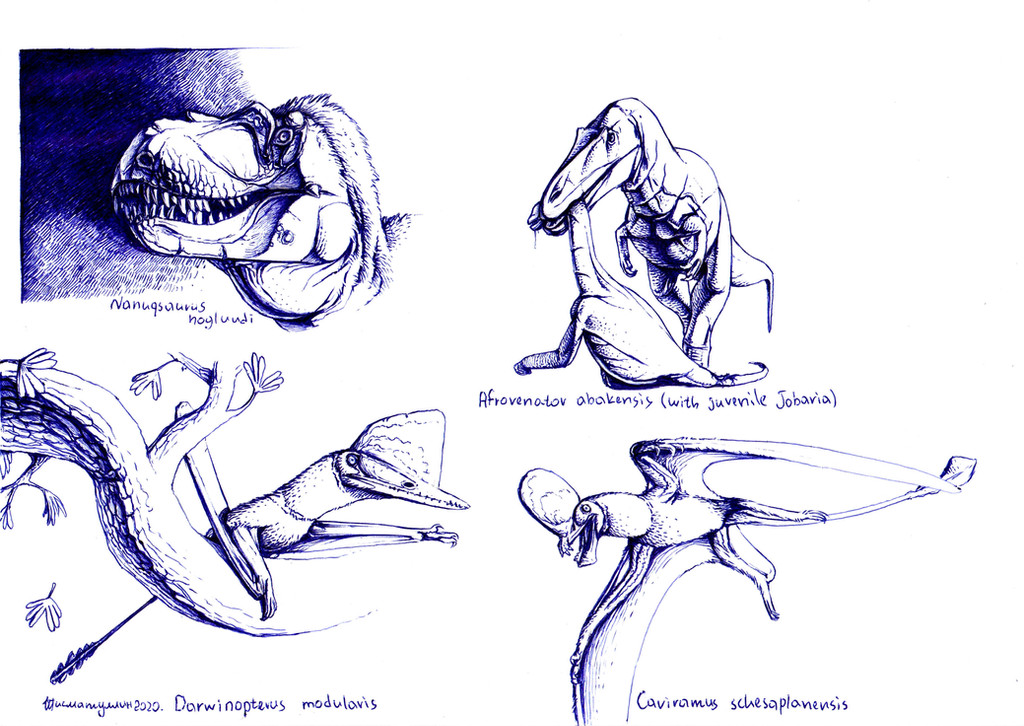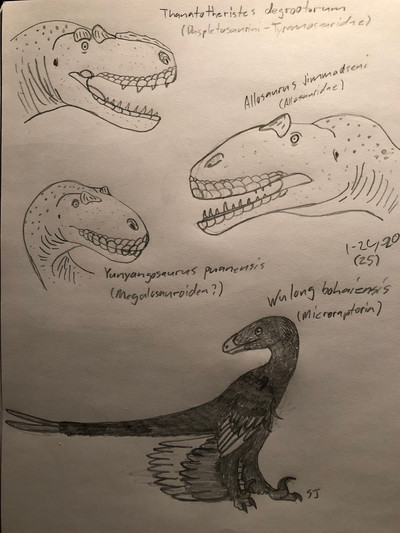HOME | DD
 Xiphactinus — Paleostream drawings 20.06.2020
Xiphactinus — Paleostream drawings 20.06.2020

#eudimorphodon #sauropod #tyrannosaurus #caviramus #raeticodactylus #darwinopterus #wukongopteridae #afrovenator #dimorphodon #gorgosaurus #jobaria #megalosaurus #pterosaur #tarbosaurus #torvosaurus #tyrannosauridae #megalosauridae #theropoddinosaur #nanuqsaurus #xiphactinusart #paleostream
Published: 2020-06-24 18:54:26 +0000 UTC; Views: 9243; Favourites: 200; Downloads: 0
Redirect to original
Description
I finally posted them. These are works from the paleostream on 20th of June. According to the results of the voting, the subject of drawing were theropods and pterosaurs, which made me very happy. 
The first is Nanuqsaurus hoglundi, a tyrannosaurid described in 2014 from skull fragments and a chunk of jaw from the late Cretaceous of the Prince Creek formation (Northern Alaska). The size of the animal was estimated at 5-6 meters - half the length of an adult T. rex. Presumably, the reduction in size was due to a seasonal shortage of food: Prince Creek in the Cretaceous, as now, was located above the Arctic circle, and there it was winter for six months.
Then we drew Afrovenator abakensis, a megalosaurid from the middle Jurassic of Niger. Since I have already drawn it, there is no need to write about this taxon here. I depicted this Afrovenator individual dragging its trophy, a young individual of sauropod Jobaria tiguidensis.
And now there are two pterosaurs. The first of them is Darwinopterus modularis, a member of the Wukongopteridae family from the middle Jurassic of the Tiaojishan formation (China). Two other species, D. linglongtaensis and D. robustodens, were described from the same formation. Darwinopterus is known for its unusual anatomy, combining primitive and advanced features such as the long tail of a rhamphorynchoid and the elongated neck vertebrae of a pterodactyloid. Darwinopterus was named after the great scientist Charles Darwin. This individual sits on a Ginkgo branch.
The second pterosaur and the last drawing here is Caviramus schesaplanensis from the late Triassic of Switzerland. Despite its primitiveness, it is very unusual for an early pterosaur. Like other Triassic taxa, it had differentiated teeth, but it also had a ridge on its nose, which during life probably supported a high keratinous structure, and very thin wing bones. Interestingly, another pterosaur, Raeticodactylus filisurensis, described from the same location, is most likely a synonym of Caviramus.
That's all. I will only say that here I decided to work with the light coming from the right. And I really enjoyed working on pterosaurs, as well as the bark texture of the Ginkgo branch.
Blue ballpoint pen, 2020.
Related content
Comments: 4

👍: 0 ⏩: 0

👍: 0 ⏩: 1

👍: 1 ⏩: 0

👍: 0 ⏩: 0
























